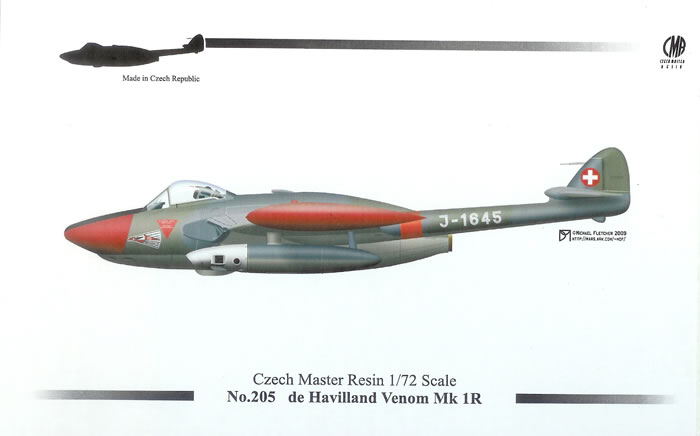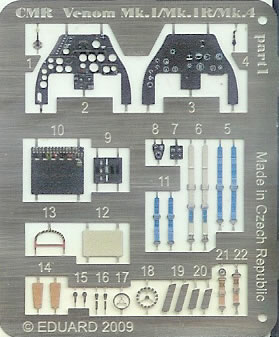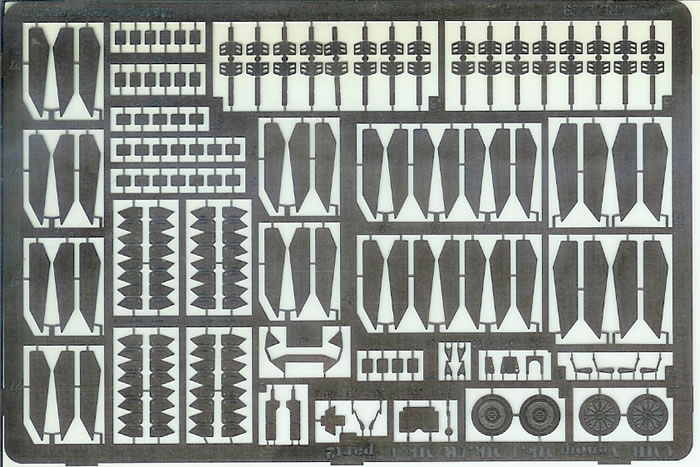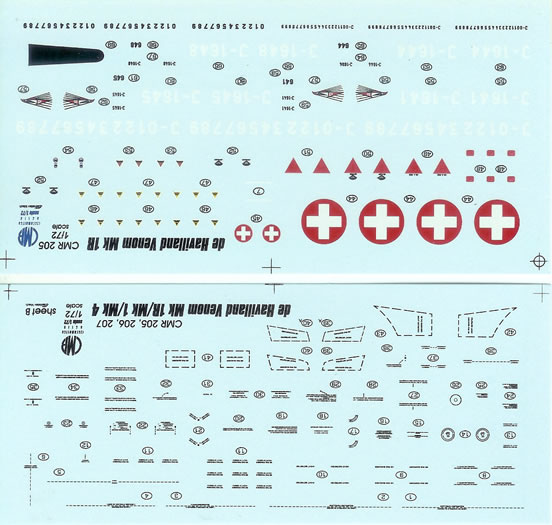de Havilland Venom Mk.1R

Czech Master Resin, 1/72 scale
S u m m a r y : |
Catalogue Number: |
205 |
Scale: |
1/72 |
Contents & Media: |
64 x cream resin airframe parts, 7 x brown resin undercarriage parts, 2 x clear resin reconnaissance pods, 1 x Eduard coloured photo-etch (PE) fret of 22 parts, 1 x plain PE fret of 85 parts (mostly weapon fins not required for this version), 2 x vac-form acetate canopies & 1x Eduard pre-cut mask |
Price: |
Available on-line from Hannants for £32.17, Squadron for US$69.29, Red Roo Models for Au$62.00, West Coast Hobbys for Cn$49.00, and various other CMR stockists. |
Review Type: |
First Look |
Advantages: |
Highly detailed and very comprehensive kit. |
Disadvantages: |
|
Conclusions: |
One of three definitive Swiss DH Venom kits in 1/72 scale. Suited to modellers with some resin and multi-media experience. A superb kit. |
Reviewed
by Mark Davies

HyperScale is proudly supported by Squadron.com
The Venom was a logical development of de Havilland’s Vampire, and was originally going to be designated the Vampire 8. However the use of a more powerful Ghost engine, and thinner wing with slightly swept leading edge led to the adoption of a new product number of DH 112 and the name of Venom. Early development problems led to a number of modifications and refinements. Perhaps the most important change for pilots from the Vampire was the installation of a Martin Baker ejector seat in all but the earliest Venom FB.1’s.
Unlike its Vampire predecessor, the Venom displayed a useful ability in the high altitude interceptor role where it proved to be quite manoeuvrable. But like the Vampire it excelled as a fighter-bomber, where its stability as a gun platform and low-level maneuverability basically outshone all-comers. This capability was to be further enhanced with the introduction of the Venom FB.4.
Although introduced to service in 1952, the Venom must really be considered to still be a first generation jet as far more advanced sept-wing types like the F-86 and MiG-15 were by then entering service. Despite this, both fighter-bomber versions of the Venom were to see extensive operational use during the1950’s in counter-insurgency campaigns in Malaya (Malaysia), Kenya Aden and Oman. They also served in a more conventional war setting during the Suez crisis when attacking Egyptian targets. The last RAF Venoms were retired in 1962.
Twin-seat Venom developments served as night fighters and all-weather interceptor for naval use in the form of the Sea Venom. These radar equipped Venoms were widely exported.
Fighter-bomber versions of the Venom were also operated by the New Zealand, Venezuelan and Swiss air forces. In fact the Swiss became the most prolific user of the Venom following licence production of 150 Mk I’s and 100 Mk 4’s. In 1970 it was decided that all Swiss aircraft should have an IFF transponder. However the Venom’s cramped avionics bay left no room for this to be fitted and so the unique pointed “Pinocchio” nose was developed and fitted to both Venoms and still serving Vampires. The Swiss retired their last Venoms in 1983 when replaced by the Northrop F-5.
Venom kits in 1/72 are not thick on the ground. I have a copy of the very good Rareplanes Venom FB.4 vac-form, and am aware of Aeroclub’s FB.1 and FB.4 kits that were limited run styrene with white metal detail parts. It is also possible to kit-bash Frog’s nice Sea Venom with a Vampire to get a Venom single-seat fighter-bomber. But by any measure, a really good 1/72 scale kit of a single seat Venom is long overdue.
The kit comes packaged in a sturdy top opening box rather than the more usual end-opening type. I’m sure that this will be welcomed by most modellers who like to use the two box halves as parts trays when building.
The parts and decals are in heat sealed plastic bags, which in turn are sealed in a further bag with the instructions and photo-walkaround. The straightforward instructions consist of six A4 pages including the parts map. The constructional illustrations are very clear and easy to follow. A further two pages gives comprehensive colour plans, whilst another illustrates the airframe stenciling. Detailed colour notes and other written instructions are in English. Three more pages provide an excellent photo walkaround focused on various detail aspects of the aircraft and reconnaissance pods, as well as some in action shots. The instructions can be viewed by following this link.
The kit’s resin parts are in CMR’s usual cream resin, and very nicely moulded with minimal presence of pinholes. The fuselage halves include the extended “Pinocchio” nose so characteristic of Swiss Venoms. A little flash is evident on the leading edges of the wings, but this can be removed easily and in seconds.
The cockpit interior is very well detailed, with components moulded on both fuselage sidewalls as well as the rear bulkhead. These areas are further enhanced by various coloured and plain PE details, including the pre-coloured two-part instrument panel.
 The ejector seat is nicely moulded and greatly enhanced by pre-coloured PE seatbelts. More detail comes in the form of PE foot rests, resin rudder pedals and control column. A nicely detailed resin gun-sight finishes the cockpit detail off. The ejector seat is nicely moulded and greatly enhanced by pre-coloured PE seatbelts. More detail comes in the form of PE foot rests, resin rudder pedals and control column. A nicely detailed resin gun-sight finishes the cockpit detail off.
Unlike their earlier Vampire kits, where the fuselage was split horizontally with the top half incorporated into the wing, CMR has chosen to split the fuselage vertically with separate wings. The inlets are also separate from the wing and have achieved some good depth. The twin booms and horizontal stabilser will need some careful alignment, but the plug and socket fit CMR has engineered will aid this. Very detailed flap and main undercarriage bays beg for careful painting, as does the nose-wheel bay. The undercarriage is rounded out with some very fine undercarriage doors and brown resin undercarriage legs. This latter medium provides greater strength than the cream resin for fine weight-bearing parts. Quite a lot of wafer-thin flash is evident on these parts, but can be removed in a minute or two of clean up.
The kit is awash with detail, and some parts are tiny. Considerable attention to detail has been paid, with separate tiny leading edge slats, quite intricate wheel well and flap detail, canopy rails, various small scoops etc Special mention should be made of the engine exhaust which has some intricate detail moulded inside and quite deep within its length.
The under-wing stores consist of two reconnaissance pods moulded in clear resin to allow for the clear camera ports. I believe these pods are indigenous to the Swiss Air Force (like many of the weapons options offered on the other two CMR Swiss Venom kits), and show the degree of research that has gone into these kits.
I’ve already commented on the two PE frets. However I should also mention that they also provide such things as trim wheels, wheel hubs, oleo torque links, undercarriage reinforcing plates, and so on. In the case of this kit you will also get a heap of spare fins for free-flight rockets and some bombs as they are common to the three CMR Swiss Venom kits but not required with this version.

Two vac-form acetate canopies allow for insurance or practice when cutting out. They come with an Eduard pre-cut mask which simply serves to make life easy when it comes to painting.

Decals are typical of CMR, being well registered and suggest good opacity. Based on past experience they should be very good to use; but like most Czech decals they will be quite thin and need to be floated into position, as they tend to adhere extremely well once there is no fluid under them.

Markings for four Swiss schemes are included; all of which are camouflaged blue-grey and grey-green over ivory, one of which has a red nose and wing tanks as well. The colours and markings plans for the schemes can be viewed here, and click here to see the stencil decals.
This is a superbly executed kit of a rather overlooked but deserving subject. Despite its tiny details and high parts count it should go together in a straightforward manner provided care is taken.
Highly recommended.
Thanks to Czech Master Resin for this review sample.
CMR Models are available
online from Hannants in the UK,
Red Roo Models in Australia
and
quality specialist model retailers worldwide.
Text Copyright © 2010 by Mark Davies
This Page Created on 9 August, 2010
Last updated
9 August, 2010
Back to HyperScale
Main Page
Back to Reviews
Page
 |
